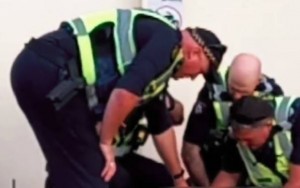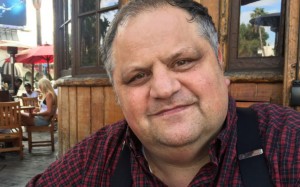Amaze CEO: Why our police must be trained in autism
Posted on
It was a story met with community outrage.
Video showed Victoria Police officers restraining a child _ the boy doubled over on the ground as the officers held him down.
‘I can’t let him kick people’
One officer says: “This is ridiculous, you’re not going to hurt my members or me, OK? … Shut up, you had your opportunity”.
At one point, the boy can be heard to cry “Let go of me”.
Onlookers are openly critical of the police, suggesting they are using inappropraite force.
An officer replies that the boy is autistic (it has since been confirmed the boy is not autistic) and he was on the roof, saying “I can’t let him kick people, and I can’t let him stand on top of the railway station bridge, where he’s going to hurt himself”.
A police spokesperson said it was easy to judge the actions of police in hindsight but they had to respond quickly, with limited information, in difficult incidents.
Amaze has formulated a response to the story based on the police belief that the boy was autistic.
That belief informed the way police responded to the situation and highlights how much work is to be done in increasing understanding of autism in emergency services.
Following are comments from Fiona Sharkie, CEO of Amaze.
“Police need training to build their skills to identity, communicate and respond to autistic people appropriately.
Time to process information
“The police approach should include asking basic questions, asking one question at a time, and allowing the autistic person time to process the information.
“The use of force should always be the last resort and used for the minimum amount of time.
“We know that if an autistic person is overwhelmed the best approach is to allow them space and time to calm themselves. A family member or support person should be notified immediately because they will have the vital knowledge to help to de-escalate the situation.
“If someone sees an autistic person having a meltdown, it may seem dangerous or frightening, but it’s much more frightening for the autistic person.
“Sirens and flashing lights can result in sensory overload for autistic people. Tension can be eased if the approach to the autistic person is calm and reassuring.
“The Victorian autism community would welcome a state-wide system where local police are trained in a consistent approach and where local police stations become familiar with autistic people in their neighbourhood.
“Such programs exist in the US where police and emergency service front line staff are being trained in autism.”
Rob Zink, an officer from the St. Paul Police Department in Minnesota has two autistic sons.
He has started the Cop Autism Response Education Project to train his fellow officers in how to interact with autistic people.
Lack of eye contact
Officer Zink stresses that law enforcement personnel should not expect autistic people to behave in the ways that non-autistic people do. For example, officers should not regard a refusal to look them in the eye as a sign of guilt.
Similar programs are underway in several police departments across the US but Steve Silberman, author of NeuroTribes: The Legacy of Autism and the Future of Neurodiversitycountry, feels more needs to be done.
Silberman, keynote speaker at the 2016 Victorian Autism Conference, has recently written for the New York Times on the need for police to gain training in autism.
Silberman wrote of an incident involving a 14-year-old autistic boy, Connor Leibel, in Arizona.
Connor was seen screaming, pinned to the ground, against a tree, by an agitated police officer.
Eight patrol cars arrived to “assist”, with the officer unaware of Connor’s autism.
The officer had interpreted the boy’s rigid, unfamiliar movements, which included raising a piece of yarn to his nose to sniff it repeatedly, as a sign of drug intoxication.
The officer was unaware of the repetitive movements that autistic people may rely on to manage anxiety and stress, known as self-stimulation or “stimming.”
That’s what Connor was doing with the string when the officer noticed him while he was on patrol.
When the policeman had initially confronted Connor to ask him what he was doing, the boy replied, “I’m stimming”. The officer was unfamiliar with the word and even though Connor tried to calm himself by repeating “I’m Okay”, the boy sustained abrasions from being held to the ground.
A similar incident occurred last year in Miami, when a young autistic man, Arnaldo Rios, briefly wandered from a group home to play with his toy truck on the street, and a passer-by called the police to report an “armed and suicidal” man sitting in the road.
When Officer Jonathan Aledda arrived, he had no idea that Mr Rios was autistic, no idea that the man trying to calm him down, Charles Kinsey, was his behavioural therapist.
Officer Aledda fired at Mr. Rios. The bullet missed him, but struck Mr. Kinsey in the leg. The therapist survived, but the trauma of the incident resulted in Mr. Rios’s being placed into more restrictive institutions.
Criticism over the handling of the Kinsey situation led to a new state law which requires Florida police officers to participate in training to help them better identify characteristics of autism


